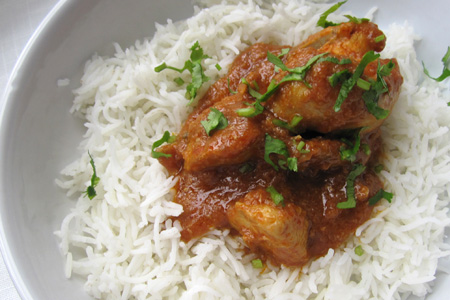

Currying Favour with the Portuguese
The great Mughal Emperor Shah Jahan, King of the World (1592-1666), died in confinement, in Agra Fort, imprisoned by his son, Aurangzeb. As he lay dying, he looked down from the balcony of the Musamman Burj tower at the pearlescent dome of the Taj Mahal he created for his beloved wife.
Shah Jahan’s reign marked an age of opulence; as a great patron of the arts and architecture, he commissioned the creation of intricate architectural wonders in present day Pakistan, such as the Wazir Khan Mosque, Lahore, built in seven years with its architecture influenced by the popular Thatta mosaic work of the 16th century…
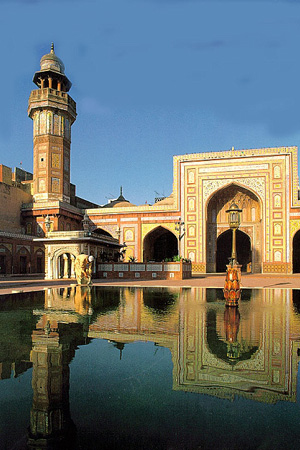
…and the Shalimar Gardens, Abode of Bliss, eight years in the making, also in Lahore. Built in 1642, the garden boasted 410 fountains, emptying out into wide marble pools. Centred among the fountains, was an area created for musicians- a mahtabi; the moonlit gazebo. Into the night the tabla, sitar, sarod and sarangi would play.
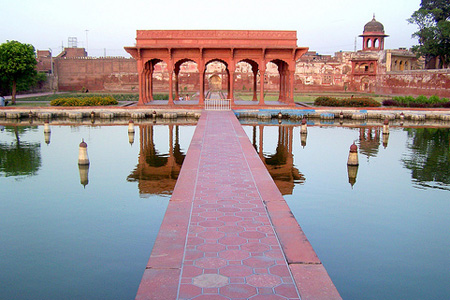
Like the architectural splendours of this era, Shah Jahan’s Imperial Kitchens were known for their excesses, similar to those of his predecessors. Hundreds of dishes were prepared every day; decadent meat pilafs fragranced with jade-green pistachios, golden sultanas, saffron, cinnamon, nutmeg and cardamom were served to portray the glory of the Mughal Empire. Innovation and discovery of new dishes was encouraged, with chefs brought in from Persia, Central Asia, and the Ottoman Empire to create dishes encompassing all the different regions.
Who says fusion cuisine is a 20th century phenomenon?
Pastries and cakes were prepared in the “European style“ by cooks previously enslaved by the Portuguese in Goa.
A little over a century after the arrival of Vasco da Gama on the shores of Calicut in May of 1498, the chili pepper- introduced to Goa by the Portugese– found its way into the Imperial Kitchens.*
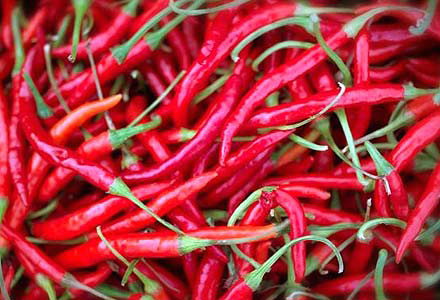
I cannot imagine my world without the chili-pepper, thank you, Vasco da Gama.
A homemade curry without the fiery quality of the chili pepper is to me, insipid at best. That brick red chili pepper powder, as if by some form of alchemy, binds itself to the tomatoes, onions, garlic and ginger, creating a luscious, unctuous curry. Whether you are from West Bengal, eating the curry and rice smothered with your fingertips, or from the Punjab, dipping into it with your light-as-air-chapati, or an Afghan-Pakistani like myself, dousing a steaming mound of Basmati rice with the curry, or from ‘Brum’ (Birmingham, UK) having it with pillowy naan and ‘a pint’ with your mates… you’re tucking into that unapologetically spicy curry because curry speaks one universal language for chili-heads.
This is the way I was taught to prepare it by Ami, my mother, who learnt it from Nani Ami, her mother. No fancy ingredients or masalas (spices) here, just some good techniques which were taught to me and a few good ingredients. The cardamom pods at the end add a subtle, lovely fragrance. Ami and I have made life easier for ourselves by using a blender, but you’re welcome to use a pestle and mortar a la grandmum.
I like to serve it with a kachumbar, a chopped salad of cucumber, tomatoes, onions, (feel free to omit the onions) and squirts of lime / lemon with some salt. The kachumbar adds another textural dimension with the acidity of the lime juice cutting nicely into the fat content of the curry.
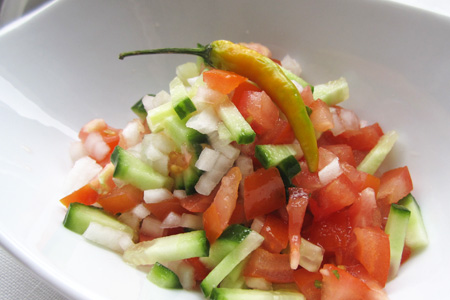
I have tried to make this with less oil, but I feel you have to go the whole hog with a curry- use the 3 tbsps of oil and if not, have an omelette or salad for dinner instead. And make the curry the next day when you’ve done that 5k run.
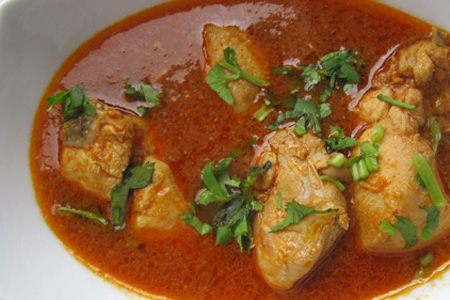
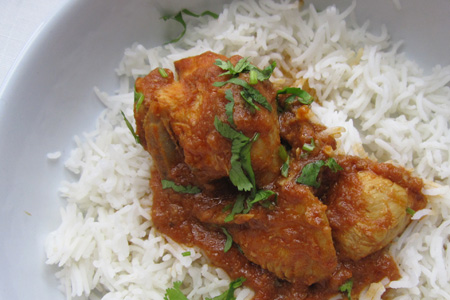
*The exact date the chili made its way to the Northern plains of India is controversial. Some believe it was two centuries after Vasco da Gama landed in Calicut; and some say the chili pepper made its way up from Goa to the North during Shah Jahan’s reign.
Photo credit Wazir Khan Mosque: TMDTUBE
Photo Credit Shalimar Gardens: Flickr
Photo Credit Chilies: Wikipedia
Serves 4 with a side of Basmati rice or chapati , (a Pakistani whole-wheat flatbread).
Ingredients:
3 tbsp canola oil (or any other neutral oil like grapeseed or sunflower)
2 lbs chicken, (I use chicken breast with bone and ask my butcher to cut it into 3in pieces or you can use a whole chicken, jointed )
1 medium-sized onion, roughly chopped (this will be blitzed in the blender later, so don’t worry about cutting it perfectly)
2 garlic cloves, sliced thin (can substitute with 1 tsp garlic paste)
1 thumb-size knob of ginger, sliced thin (can substitute with 1 tsp ginger paste, if ginger not available, can omit)
28 oz / 400 ml can chopped tomatoes or tomato sauce (passata) or 4-6 large fresh tomatoes, chopped
1 1/2 tsp salt (adjust to taste)
pinch haldi (turmeric powder)
1 1/2 tsp red chili powder (I would start with 1/2 tsp) In fact, you can use red chili pepper flakes, dried Calabrian chilies, whole dried red dried chilies, fresh green chilies like thai bird, serrano or jalapeno- play around with any chili you have at hand.
1/2+1 1/2 cups water
2 cardamom podsPreparation:
*Turn the heat to medium and place a heavy-bottomed pan, (I use a 6 qt stockpot) on the stove. To really bring out the nutty golden colour of the onions, it is preferable to not use a non-stick pan.
*Add oil and allow pan to heat up for 2 minutes.
*Add onions and saute till they start to turn golden.
*At this point, add the fresh garlic and ginger and continue to sauté.
*The onions will start to darken more, don’t worry, this is what will give the curry its dark, intense colouring. The garlic and ginger will also begin to caramelise at this point.
*This will take a total of 15 minutes.
*Add tomatoes, salt, chili pepper and turmeric and turn the heat to medium or medium-high, start to “fry” (bhuno) this mixture. Be careful, the tomato sauce may splatter, in that case, turn the heat down. It will take approximately 15-20 minutes.
*By the end of it, you should see the sauce has reduced and looks jammy.
*Let the mixture cool a bit and transfer the chunky ingredients with a slotted spoon, to a blender.
*Blitz it all to a smooth paste, add some water to the blender if you want to get all the sauce off the walls of the blender.
*Transfer mixture back to the pan.
*Add chicken pieces and 1/2 cup of water and turn the heat to medium-high.
*”Fry” (bhuno) the chicken till you start to see the oil separating from the sauce. This is an indication that it is almost done. This will take approximately 15-20 minutes and rigorous stirring.
*Add the remainder of the water- 1 1/2 cups and cardamom pods, turn the heat to low, cover with a lid and let it simmer for 20 minutes. The oil should have floated freely to the top of the curry by the end of it.
*Serve with a garnish of fresh chopped coriander/cilantro, (both leaves and sweet stems), kachumbar and chapati or Basmati rice
Note: If using garlic and ginger paste, add the paste once the onions have fully darkened, otherwise the paste will burn.
the curry looks very beautiful and delicious. I would have it with the equally beautiful rice that you cooked. I enjoyed your story about Shah Jehan and his extravagant life…I can only imagine the splendour of the time.It must have been quite a sight to dine in a palace or simply to watch the cooks at work! O MY!
I will tell you this: I read this post with enchantment, I love that you take me back home with you and I get to imagine what a wondrous place you have left. The curry is just icing on the cake!
This looks incredible. I love spicy curries so I think I’ll give this a try tonight!
If I’m remembering right, Shah Jahan commissioned a mirror image of the Taj Mahal for his own tomb. It was to be built in black marble on the opposite bank of the Yamuna river, only to have it canceled by his puritanical son Aurangzeb. I know it’s meant to be a bit of a myth, but what a lovely story it makes.
I’m a newcomer to making Kachumber, but it really does add something to the whole meal – a tart and zingy contrast to the unctuous spicy heat of the curry.
What’s really interesting to me though is the blending of the cooked onions etc to make a paste – I’ve never cooked South Asian curries like this, although I have done it with SE Asian dishes. I’m going to have try it and see what difference it makes. I’d imagine it gives you a much smoother sauce for a start.
Shayma
This looks gorgeous!
Another lovely article, Shayma! 🙂
Interestingly, there are some parallels here with how my mum makes her Croatian stew! She does the browning of the onion, though not as dark, and she does the bhunoing!
Once again, a great post. Can’t wait to try this out, slight variation to the way my ma taught me. Will let you know how it goes!
Along with your lovely food thanks for bringing Pakistan back in the limelight 🙂
Shayma, this is by far the best post I have ever read/looked at, ever. I’m full just from its historical and cultural aspects, but like a good meal, didn’t want it to end.
As a friend sends me spices by mail that are unavailable in CV and since the chilis are a vestige of CV’s colonizers, the Portuguese–I’ll go pick some straight from the tree–I’ve precisely what I need to prepare this mouthwatering dish…tonight. xx
That does look delicious so I can’t wait to try it. A lovely article with beautiful photographs too.
@Zurin Thank you so much, what a glorious period that was!
@Tasteofbeirut Thank you, J. I wish we maintained our monuments the way the Europeans do. I feel so sad when I go to Shalimar Gardens and see the moss growing in the empty pools. By the way, love your new avatar 🙂
@The Grubworm That is a beautiful story, even if it may be a myth, thank you for sharing. It has also been said that Shah Jahan built the Taj Mahal to portray his might as a Mughal Emperor, rather than his love for his wife. I don’t see why the two should be mutually exclusive.
I saw your kachumbar in your lastest post, I like how you used red onion.
Thank you, you are right, it makes the sauce smooth- there is nothing worse than a curry with bits of chopped tomato skin or onions floating about! 😉
@Sunflower Good to hear from you, thank you. x
@Maninas Thank you- how lovely to hear about culinary crossovers. Hope you post it on your blog, soon.
@Ayeesha Thanks so much, curry is always something one learns from one’s mum, right? Along with lentils and rice, too. Am sure her curry is your signature dish. x
@Taniya Thanks, long live Pakistan and may it prosper! x
@Debbie Thanks for your kind words. You are lucky to live in Cape Verde; a beautiful place where you can pick some straight from the tree. How I envy you for that.
@Jackie Thank you so much. Buon appetito.
Curries have got to have chili, right, right? Are there curries without?!
@Su Lin Well said! I suppose curries without chili would be labeled a stew, perhaps. Or a khoresh (Persian), for eg., which in my mind, is a totally different (beautiful) animal. Curry=chili! (and no “curry powder”, please tee hee)
Thanks for the blender tip! My curry was always lumpy. My moms recipe is very similar other than a heaped teaspoon of corriander powder, which i guess is a staple of Memon cooking.
Looks so, so Yummy! I can’t wait to try this. My Mom uses a blender as well 🙂
@Nida Thank you for visiting. My Khana (aunt) adds dhania (coriander) powder, too, that definitely gives it another dimension of flavour.
@M Thank you, M. x
If you were my daughter, I’d print this out, stick it on the fridge, then point it out to whoever came into my kitchen. (It would get the most exposure that way.)
I’m printing it to read it once more and couldn’t resist.
🙂
Beautiful! Oh, the picture of he chili peppers, so stunning..
I’m willing to bet this seemingly simple curry has a rich depth of flavor. Can’t wait to try it out. Thanks for posting this 🙂
Love the history and architecture info, btw.
I will be spending my Saturday making this! Sabahat has never mentioned the blender step. I think it will work fabulously!
ditto on the “can´t imagine my world without the chili peppers” Love your recipe!!! how simple you´ve made it – complimenti!!! can´t wait to try your version – all my curries involve lots of chopping – onions, aubergines, courgettes, bell peppers…(whatever we´ve got in the frig)
Thanks Shayma – oh yeah, just remembered our laughs about cilantro – remember? (i also always garnish the curry with chopped cilantro) la erba malefica? never found out why italians hate is so… besitos
Hi Shayma
Anoher recipe which looks delicious and simple to prepare.
I have a question re chili powder – I have about 5 different kinds of powder as I make a lot of Mexican food, but I know these spices are different. I can only get “piment doux” here in Lyon. I have some old cayenne knocking around – what type of red chili powder do you use and would you recommend to get heat into the curries?
Thanks as always!
Jo
Finger licking good curry Shayma, I love it. Yes, indeed, the 3 tbsps oil have to be there. I love a hearty good curry, and this looks wonderful. Oh forgot to tell you. Went into Old Delhi last week, and an old cook from there served us the most divine mince with fresh tandoori rotis. Pestered her for the recipe…will post it one day!!
{HUGS}
@Debbie Thanks, Debbie, you’re very kind.
@Mothership Thanks, dear. Sadly, I can’t take credit for the chili photo- it is from Wiki.
@Bria Thank you, as always. I like to use as few spices as possible; I feel, in my humble opinion, that it makes the dish really stand out without masking it with too many flavours.
@Arjumand Arj, thanks. I think you need to go easy on Sabahat 🙂 Your fault for not having learnt from one of the best mom cooks in the world 😉
@Nairy jan, thanks ever so much. How can I forget that? Love the Italiani, but they do hate the cilantro! So many wonderful memories of your trip to Rome. baci, x s
@Jo Thank you. I don’t speak French but I suspect piment doux is capsicum powder, that would not work, but cayenne would certainly work. I use cayenne, which is found in Pakistani or Indian stores. But any kind of hot chili pepper could be used- ancho, chipotle, even chili pepper flakes, which you may be able to find in France more easily than cayenne pepper. Small dried chilies which are imported from Italy may also be easy to find. My favourite chili pepper comes from Ethiopia, which I used to be able to find in gourmet food stores in Rome. Hope this helps!
@Deeba Thanks, Deeba. One just can’t get the onions to brown without the oil, and then how can the curry be good without caramelised onions, right? Ah, Old Delhi, must be gorgeous, keemay wali roti sounds gorgeous- recipe soon, please! x s
MMmm I can almost smell it off the page! Thanks for mentioning Birmingham, I lived there for a while and still miss the food, and those giant naan.
Sunshine for you at mine (sorry if you got it already) http://geekymummy.blogspot.com/2010/02/sunshine-award.html
Delicious food and writing both.
Inspiring stuff for every sense really.
Oh, what a wonderful story and what a tale of “fusion” cuisine. What great cuisine hasn’t come about because of people carrying new ingredients to new countries? And fabulous curry! Looks so delicious!
What a great post, I wrote a post about Vasco De Gama too 🙂 http://gastrogeek.wordpress.com/2009/10/31/coconut-prawn-currychingri-malai-tarkari – I think your photos are stunning.
Your blog is just getting better and better! Beautifully written post and stunning photos. I never knew that controversy about the chilli pepper. This is just fantastic stuff.
great post Shayma joon! love the story and the history of Taj Mahal, hope to visit the place someday! curry looks great with red hot chili pepper, i’m impressed!
Shayma, I loved the chicken recipe but eagerly await a daal dish…the rescue squad of the vegetarians!!
@geekymummy My Aunt and cousins live in Solihull, so we go into Brum a lot for some good Pakistani fare. Thank you for the lovely Sunshine Award I have put the widget up in my “Press and Praise” section. Sending sun rays right back to you. x
@Rachel Many thanks.
@Gastrogeek Thanks, Rej. I went back and read your excellent post.
@Ollie Thanks so much. Lots of inspiration from you lot. x
@Azita Joon, Thanks, as always for your lovely words. While at the Taj Mahal, please swing by Pakistan, too, we’d love to have you and show you around our beautiful country 🙂
@Gourmand That’s going to be the next post, soon, after a dessert post, promise. Lurv, s
wow what a curry and the Taj Mahal is amazing we went a few years ago great post, shame we couldn’t have eaten food from his kitchen!
A beautiful post with lots of information. Thank you!
Yes we can never thank Vasco our man for the introduction of chillis, Indian food would never be what it is without it. I love this chicken recipe n its a regular at home … comfort food :)) Lovely write up on the history of Aurengzeb:)
@Rebecca Shame it is to not have been able to eat from a Mughal Emperor’s kitchen; we’ll just have to recreate it in our own!
@Shari Thanks, hope you’re well. x
@Kajal Thanks for your kind words 🙂 Yes, food from Pakistan (and India) would not have been the same without the chili, that’s for sure.
Bookmarked Shayma, simple chicken curry at its best
I know this chicken recipe and it is so delicious. Now, I learned the recipe too.
Iffet
Shayma this looks amazing… I love the history behind it. Sometimes we eat dishes without really knowing how they came about. I would eat it with rice. I think it’s going to be on my menu for next week! Thanks!
I love that you appreciate the need for spiciness. Food in Cairo tends to be very bland, and anything that I can find with a kick, I eat. I’ll have to try this recipe. What’s your suggestions for the best spicy curry to get next time I am in Pakistan.
http://foodjihad.wordpress.com/
@Bongmom Thank you for your kind words.
@Iffet Thank you for visiting.
@Nour The best recipes, I feel, are the ones handed down to us by those we love. Thank you so much.
@Food Jihadist Thank you. Where in Pakistan will you be? A curry is difficult to find in restaurants in Pakistan; it’s mostly something to be found in homes. If you are in Karachi, try BBQ-Tonight, they do a lovely ginger chicken. In Lahore, there is Mirchi (casual) on MM Alam Road or Dumpukht and Bukhara (both formal) in the Pearl Continental Hotel. To be honest, I always eat at home in Lahore, unless my Uncle brings a chicken karahi and kebabs from Food Street. I don’t know Islamabad at all, so wouldn’t be able to make any suggestions.
Lovely pictures, I am now craving curry at 10am! Really interesting recipe too, I don’t think I’ve ever made a curry without at least a little cumin in. Definitely on the to-do list.
@Lizzie Thanks very much. Some people also add a little bit of coriander powder. It goes well with chicken. x s
Hi
Thanks for the gorgeous recipe, but I have one question. After bltizing the paste you say add it back to the pan together with the chicken and fry ? I’m confused, how will the chicken ‘fry’ in a tomatoe gravy ?
M
@Meena Hi Meena, by “fry” I mean add the chicken and paste back in the pan and turn the heat to high, this is the process of ‘bhun-na’. No additional oil is required for this process. Thanks for visiting, please do email me if I can help you any further.
I came across this site and was instantly attracted by the pictures and the delicious sound of the recipe. I also found your Kulfi recipe and decided to have a dinner party for 6 in “The Pakistani Manner!” The dinner was a great success, and people loved both recipes, but I found I had to make some rather large alterations in the preparation of the chicken and decided to send them in to this site.
Such a thick tomato-based sauce cannot be cooked over medium high heat without it exploding all over the stove, nearby walls, and even the cook’s clothing and face! As well, I assume the sauce was to be transferred to the blender with a “slotted spoon” so that the slices of ginger could be removed prior to the blending…? Well, my sauce was so think that it would not drain through the slotted spoon, so I was reduced to trying to press it through a sieve with the back of a large spoon. NO FUN! And the sauce was already smooth so I eliminated the blender step as being completely unnecesary. I know that chicken, to retain its juciness, must be quickly browned before adding it to sauce, so I also did that. And then to avoid the violent spitting of the sauce during further cooking, I covered my Creuset Dutch Oven and stuck it into the oven for 1 hour at 350! What emerged was fabulous, and we all loved it.
By the way, the Kulfi was great, too, but I expected it to be smooth and it was not because of all the almonds and pistachios.
Janet- Thank you very much for writing in. Even though I have written an email to you, I thought I would respond here, too, for the benefit of other readers. I am so sorry the tomato sauce splattered all over you, regrettably, stovetop temperatures vary. What may work on medium-high heat in my kitchen, may not work on yours. I shall take this into consideration and change the wording to medium/medium-high heat.
According to this recipe, you would have to transfer the browned onions, ginger, garlic and tomatoes into the blender to get a velvety-smooth consistency. Browning onions, ginger and garlic (the holy trinity!) is essential to getting the right flavours and colour to this dish.
Thank you for writing in with your experience.
This is by far the best curry I’ve ever had. Thankyou!